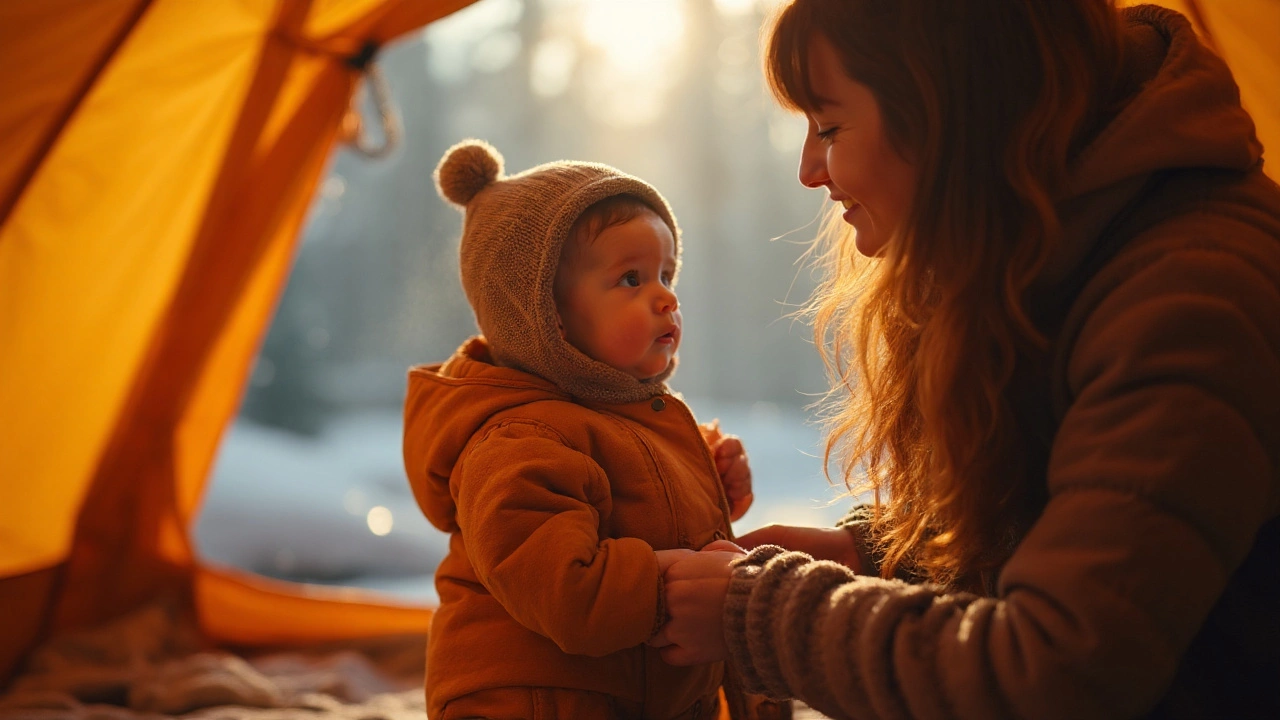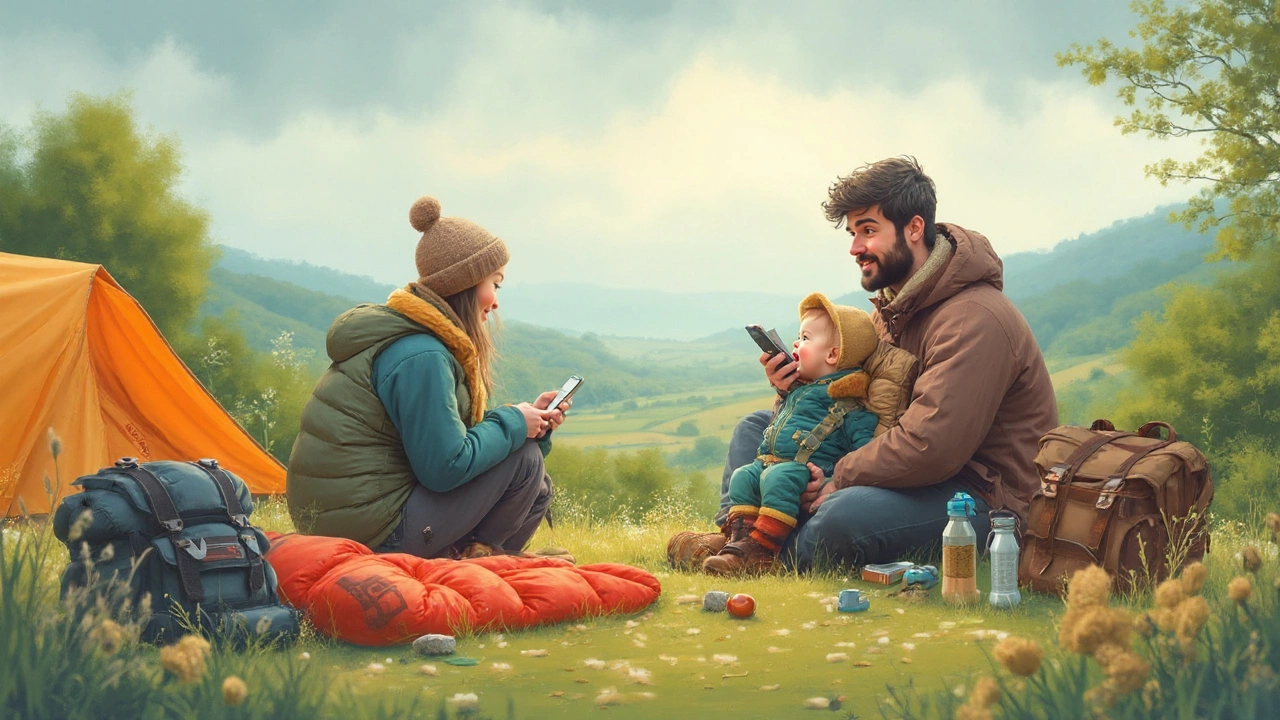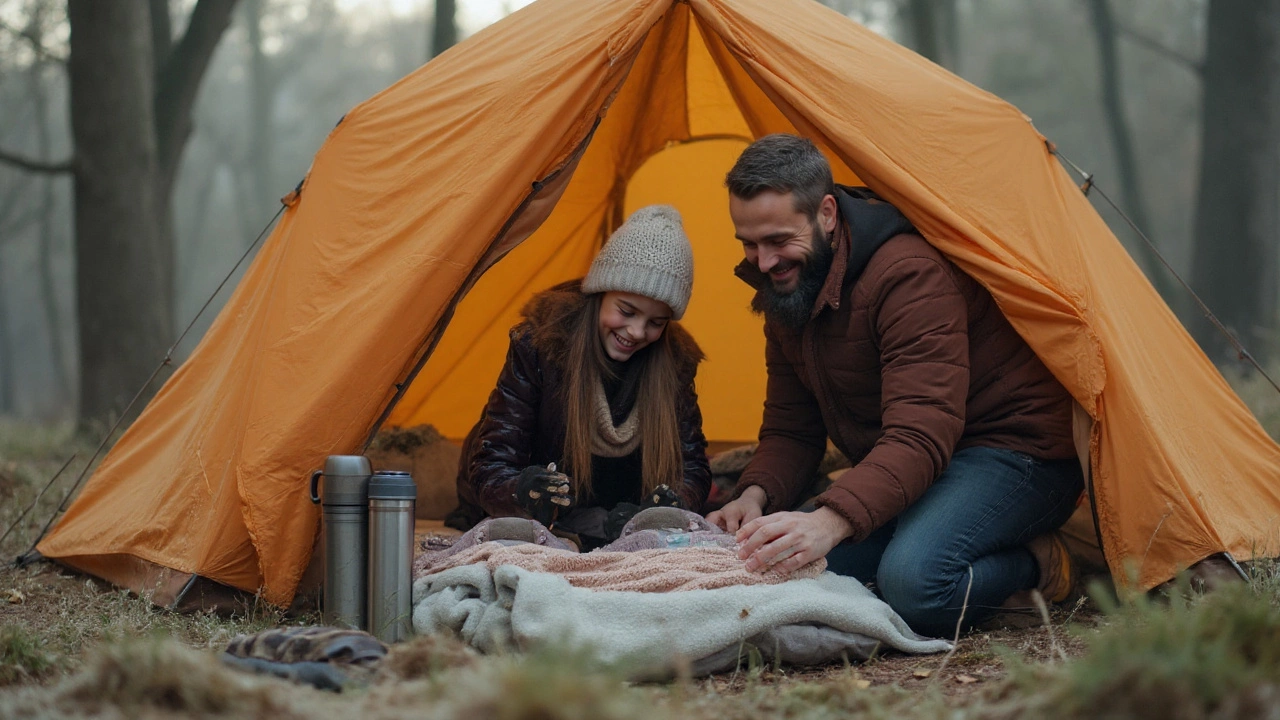Babies don’t come with an instruction manual for surviving the wild, but here’s a stat that always surprises new parents: a baby is about three times more vulnerable to cold than a full-grown adult. Their tiny bodies just aren’t built for weathering frigid conditions. But what counts as “too cold” for camping with a baby? There’s an unspoken rule in family camping: nobody wants to be the reason their little bundle gets frost-nipped toes—or worse, something serious like hypothermia. Yet, loads of newbie (and even experienced) parents head out anyway, often armed with too little info and too much confidence. It might sound dramatic, but when the nighttime lows sneak into single digits Celsius, the risks shoot way up. The truth is, it’s not just about what gear you pack—it’s about understanding the real line between fun and danger when your camping buddy wears diapers.
Understanding Safe Temperatures for Babies: Where Is the Cutoff?
If you dig into pediatric recommendations, you’ll find a pretty clear bottom line: overnight temperatures below 10°C (50°F) are often downright risky for babies under 12 months. The Canadian Paediatric Society and UK NHS both warn that infants can develop symptoms of hypothermia even at these moderate chills, especially when combined with damp air and wind. Babies’ bodies lose heat four times faster than adults’, and they can’t shiver efficiently or regulate their own body temps very well. Now, that doesn’t mean you need to pack up at the first hint of cool air, but it should make you rethink those Instagram shots of babies bundled up on frosty spring or autumn mornings. Here’s the kicker—a baby doesn’t have to feel icy to be at risk. In fact, their skin might stay warm while their core temperature is dropping dangerously low.
If you ask most family doctors, they’ll be even stricter: They suggest only camping overnight with babies when the low forecast stays above 13°C (about 55°F). That’s because even with good gear, babies can wiggle blankets off or end up face-down, and accidents happen. Some research out of Scotland back in 2023 found hospital admissions for hypothermia in children under one spiked following nights where the temperature dipped below 10°C—regardless of apparent comfort at bedtime. The safest zone? Daytime highs in the low twenties Celsius (70s Fahrenheit) and overnight lows no chillier than a light sweater-for-you kind of night.
This all gets more complicated when you factor in humidity, windchill, and the baby’s health. Premature babies, babies under 6 months, and babies with chronic conditions are more susceptible. Even if you’ve got Nordic ancestry and feel bulletproof in the cold, your baby’s physiology just isn’t there yet. If you’re camping at altitude, subtract another degree or two from your comfort threshold—higher elevations cool off fast at night, and air that seems fine at sunset can turn frosty by dawn.
So where do most accidents happen? It’s not deep winter—it’s September and May, that shoulder-season sweet spot when days are mild, but nights surprise you with a chill. Even in the UK, places like the Lake District and Scottish Highlands regularly see summer night temps drop to 8°C (46°F) or lower. A quick check of Met Office records shows June averages for overnight lows in Snowdonia often hover around 7°C. For context, hypothermia in infants is officially defined as a core body temp below 35°C, but subtle symptoms (cool skin, fussiness, lethargy) can start showing up just below 36.4°C.
| Location | Average June Nighttime Low (°C) | Risk for Babies |
|---|---|---|
| Lake District, UK | 8.3 | High |
| Snowdonia, UK | 7.1 | High |
| Cairngorms, Scotland | 6.5 | Very High |
| Cornwall, UK | 11.2 | Moderate |
All this isn’t to scare you off camping with your baby, but to get strategic. Ask yourself: does the forecast low stay above 10°C? Is the air dry, or is it that bone-chilling damp kind? Are winds expected to be strong? Factor those in. Missing a trip is nothing compared to the hospital bills (and regret) that come with a hypothermic baby.

Spotting the Red Flags: Babies and Cold Weather Risks
The scariest thing about babies and low temps is that the warning signs often slip by unnoticed—unlike cranky toddlers, infants rarely complain until things get serious. A cold baby doesn’t always cry; sometimes, they just get oddly still. If you’ve never seen a baby cold enough to stop moving, count yourself lucky—that’s the first hint things are getting dangerous. Hypothermia in babies initially shows as pale (or bluish) skin, shaking (if they’re older), weak sucking when feeding, or just acting really “off” and quiet.
The reason this is so risky? Babies have way more skin surface area compared to their mass, so they bleed heat fast. Once their core temp slips, things can spiral before parents realize. It doesn’t help that a baby’s head is a heat-loss superhighway—making up almost one-fourth of their body surface area. In one 2021 German field trial, babies exposed to 12°C air temps for just four hours, even with layered clothing, still exhibited a measurable dip in core temp unless heated sleeping pads or proper sleeping bags were used. And you know those adorable baby sleeping bags? Most aren’t actually warm enough for real outdoor overnights unless specifically rated for cold-use. Always check the tog ratings—anything less than 2.5 to 3.5 isn’t cut for chilly nights, and even that rating assumes the baby is dressed well underneath.
Let’s get real about gear. There’s a myth that piling on more and more blankets keeps a baby safe, but loose bedding ups the risk of SIDS (Sudden Infant Death Syndrome). The NHS and American Academy of Pediatrics both recommend nothing loose in the sleep space, even while camping. So, swaddling? Only if baby isn’t rolling yet. For older babies, stick to fitted thermal sleep suits and properly sized sleep sacks. Thermal hats can help, but never cover the face or tie anything around the chin—it’s a strangulation risk.
So what should you watch for overnight? Do a quick check as soon as you wake for your own pee run. Hands and feet can feel cool, but if the baby’s torso, neck, and head feel chilly—even with clothing—they’re already veering into “too cold” territory. Fussiness, rapid breathing, a weak cry, or fruitless attempts to wake the baby should have you thinking about warming up, regardless of the forecast. Some pro campers recommend a digital thermometer on your baby’s upper chest or armpit (not the forehead strips—they’re useless outdoors). If it’s dipping below 36.4°C, warm up fast and don’t second guess.
If you do ever suspect mild hypothermia—meaning the baby seems sluggish, colder than usual, but alert—move them next to your body inside your sleeping bag for direct skin contact, strip off any wet clothing, and gradually rewarm. For any signs of confusion, trouble breathing, or stops responding, call emergency services, no matter how remote. Cold-related issues can escalate so quickly with infants that waiting it out is never the answer. That’s not to say every chilly tent night will end in disaster—but those are the risks you have to factor into every plan.

Packing and Planning: How to Keep Your Baby Warm and Safe Outdoors
This is where the rubber meets the road, or in our case, where the onesie meets the chilly sleeping mat. The only way to keep a baby safe when the temp flirts with the danger zone is planning for every single variable. Rule one: check the hourly weather, not just the daily highs and lows. It’s those pre-dawn hours (around 4 to 6 a.m.) where temps will hit rock bottom and babies are most at risk. If there’s a cold snap in the forecast, reschedule. No trip is worth gambling with your baby’s health, period.
Start your packing list by thinking in layers, not bulk. Babies heat up and cool down fast. Ditch anything cotton—once it’s damp, it’s useless at keeping heat. Go for wool or technical synthetics: a thin long-sleeve base layer, followed by footed fleece zip-ups, and finish with a thermal sleep sack or baby-grade down bag. If you invest in anything, make it a sleeping pad that insulates from the ground—a huge heat-thief in spring and autumn. Studies out of Norway showed that infants lose as much as 25% of their overnight heat through under-insulated bedding, especially when the mat is just a folded blanket or basic foam.
Pack at least two complete sets of warm baby nighttime clothing, in case one gets wet from a spilled bottle or nighttime accident. Portable baby-safe heaters feel tempting, but most safety bodies say no to open flames or heated stones anywhere near baby bedding. If you’re wild camping, stick tight to established campgrounds with shelter options. Some UK family-friendly sites offer insulated pods that make overnight safety nearly foolproof.
Let’s talk feeding. Babies burn more calories keeping warm, so expect hungrier nights. Breastfed babies often cluster feed on cold nights for this reason. For bottle feeders, a thermos of warm (not hot) water helps speed up midnight feedings without chilling the milk or formula—and gets you back to bed faster, too. Staying hydrated helps babies retain heat, so don’t get lax with nighttime feeds.
If your campsite allows, aim for a tent that’s at least two-persons larger than your human count—it helps keep the adult body heat circulating while leaving extra space for safe sleep arrangements. Ventilate the tent, but keep doors zipped against wind. Lay your baby’s sleep space close to yours but on a firm, insulated mat, away from direct drafts. No baby ever needs to sleep on an air mattress in the cold—those things sap warmth like nothing else.
Camping with a baby isn’t about proving how tough you are—it’s about making smart calls so everyone stays happy and healthy. If you see fogged breath coming from your baby, or the tent’s walls are heavy with condensation, odds are it’s colder than you think. Use portable digital thermometers to keep tabs on both the air and your baby’s temp. If you’re car camping, keep backup heat sources, like extra blankets, and hot water bottles—but never leave them in the cot as they’re a burn risk.
Remember, the best camping memories come from safe, well-thought-out trips. It’s not wimpy to switch your plans if the weather’s off or to stay close to home the first few overnights. Parents who camp regularly with their babies usually start with short, fair-weather trips, build skills, and only then edge into colder nights once they know exactly how their kid reacts. There’s no shame in erring on the safe (and toasty) side—you’ll have plenty of time to show your baby snow later, once their bodies are ready for the bigger adventures. Safe, happy kids mean more time around the campfire in the long run.
